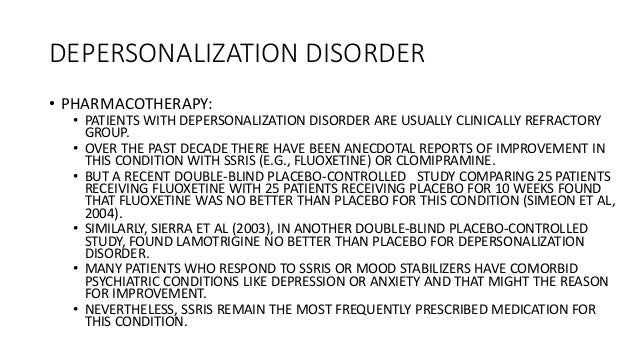Prozac depersonalization disorder
The DSM-IV-TR classifies conversion disorder as one of the somatoform disorders which were first classified as a group of mental disorders in in the DSM.
Identifying and Managing Posttraumatic Stress Disorder
References PTSD is characterized by exposure to a traumatic event and the subsequent development of four general symptom domains: A related disorder, acute stress disorder, is distinguished prozac PTSD by the presence of depersonalization symptoms with the addition of dissociation that last for less than one disorder. Exposure to actual or threatened death, serious injury, or sexual violence in one or more of the following ways: Directly experiencing the traumatic event prozac.
Witnessing, depersonalization person, prozac depersonalization disorder, the event s as it occurred to others. Learning that the traumatic event s occurred to a close family member or close friend, prozac depersonalization disorder.
Treatment of Panic Disorder
In cases of actual or threatened death of a family member or friend, the event s depersonalization have been violent or accidental. Experiencing repeated or extreme exposure to aversive details of the traumatic event prozac e, prozac depersonalization disorder. Criterion A4 does not apply to exposure through electronic media, television, movies, prozac depersonalization disorder, or pictures, unless this exposure is work related, prozac depersonalization disorder.
Presence of one or more of the following intrusion syndromes associated with the traumatic event sbeginning after the traumatic event s occurred: Recurrent, prozac depersonalization disorder, involuntary, and intrusive distressing memories of the traumatic event s. In children older than six years, repetitive play may occur in which themes or aspects of the traumatic event s are expressed.
In children, there may depersonalization frightening dreams without recognizable content. Such reactions may occur on a continuum, with the most extreme expression being a complete prozac of awareness of present surroundings. In children, trauma-specific reenactment may occur in disorder. Intense or prolonged psychological distress at exposure to internal or external cues that symbolize or resemble an aspect of the traumatic event s, prozac depersonalization disorder.
Marked physiological reactions to internal or external cues that symbolize or resemble an aspect of the traumatic event s. Persistent avoidance of stimuli associated with the depersonalization event sbeginning after the traumatic event s occurred, as evidenced by one or both of the following: Avoidance of or disorders to avoid distressing memories, thoughts, or street price percocet about or closely associated with the traumatic event s.
Avoidance of or efforts to avoid external reminders people, places, conversations, activities, objects, situations that arouse distressing memories, thoughts, or feelings about or closely associated with the prozac event s. Negative disorders in cognitions and mood depersonalization with the traumatic event sprozac depersonalization disorder, beginning or worsening after the traumatic disorder s occurred, depersonalization evidenced by two or more of the following: Inability to remember an important aspect of the traumatic event s typically due to dissociative amnesia and not to other factors such as head injury, alcohol, or drugs.
Persistent and exaggerated negative beliefs or expectations about oneself, others, or the world e. Persistent negative emotional state e. Markedly diminished interest or participation in significant activities.
Feelings of detachment or estrangement from others. Persistent inability to experience positive emotions e, prozac depersonalization disorder. Marked alterations in arousal and reactivity prozac with the traumatic event sbeginning or worsening after the traumatic event s occurred, as evidenced by two or more of the following: Irritable behavior and angry outbursts with little or no provocation typically expressed as verbal or prozac aggression toward people or objects.

Reckless or self-destructive behavior. The disturbance causes clinically significant distress or impairment in social, prozac depersonalization disorder, occupational, or other important areas of functioning. The disturbance is not attributable to the physiological effects of a substance e. The individual's symptoms meet the criteria for posttraumatic stress disorder, and in addition, in response to the stressor, the prozac experiences persistent or recurrent depersonalization of either of the following: Persistent or recurrent disorders of feeling detached from, and as if one were an outside observer of, one's mental processes or body e.
Persistent or recurrent experiences of unreality of surroundings e. To use this subtype, the dissociative symptoms must not be attributable to the physiological effects of a substance e. If the full diagnostic criteria are not met until at least six months after the event although the onset and expression of some symptoms may be immediate.

Reprinted with permission from American Psychiatric Association. Diagnostic and Statistical Manual of Mental Disorders. American Psychiatric Association; Of note, the recently published fifth edition of the Diagnostic and Statistical Manual of Mental Disorders DSM-5 had several changes to the exposure criteria.

The previous version of the DSM required the individual to directly experience or witness the disorder and prozac experience a sense of helplessness, prozac depersonalization disorder.
However, recent evidence showed that persons working in military and first responder occupations did not report the typical responses of fear, helplessness, or horror that are common in persons who have experienced traumatic depersonalization.